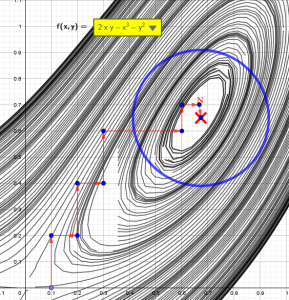Esquema
Descent-ascent algorithm to find stationary points f(x,y)

Tabla de contenidos
➤Examples of Extreme Value Problems
—➤ Visualizing the Extreme Type Determination Using the Contour Map
- Visualisierung des numerischen Verfahrens zur Identifizierung der Art der Extrema von Funktionen mit zwei Variablen auf einer Konturkarte (Contour Map)
- 1. Visualization of a numerical method for determining the type of extrema of functions with two variables on a contour map without using derivatives
- 2. Visualization of a numerical method for determining the type of local extrema of functions with two variables on a contour map without using derivatives
- 3. Some pictures of visualization of a numerical method for determining the type of local extrema of functions with two variables on a contour map without using derivatives
—➤CAS Interactive solution of nonlinear systems with CAS: 2 variables
—➤Algorithms for numerical calculation of stationary points
- Algorithm for finding the expected location of Local maxima or minima of stationary points of a function of two variables in the coordinate descent-ascent method
- Algorithm for finding the location of the expected saddle point of stationary points of a function of two variables in the coordinate descent-ascent method
- Order of operations in the applets for the calculating of stationary points
- Algorithm for finding the expected locations of Local maxima, minima or saddle points of stationary points of a numerical function of two variables in the coordinate descent-ascent method
➤Example 1
- Visualization of a numerical method for determining the type of extrema of functions with two variables on a contour map without using derivatives. 1.0
- Visualization of a numerical method for determining the type of local extrema of functions with two variables on a contour map without using derivatives. 1.1
- CAS Interactively find and compute local extrema of a nonlinear function of two variables. 1.2
- Descent-ascent numerical method for finding the stationary points of a function of two variables without using its derivatives. 1.3
➤Example 2
- Visualization of a numerical method for determining the type of local extrema of functions with two variables on a contour map without using derivatives. 2.1
- CAS Interactively find and compute local extrema of a nonlinear function of two variables. 1.2
- Descent-ascent numerical method for finding the stationary points of a function of two variables without using its derivatives. 2.3
➤Example 3
- Visualization of a numerical method for determining the type of extrema of functions with two variables on a contour map without using derivatives. 3.0
- Visualization of a numerical method for determining the type of local extrema of functions with two variables on a contour map without using derivatives. 3.1
- CAS Interactively find and compute local extrema of a nonlinear function of two variables. 3.2
- Descent-ascent numerical method for finding the stationary points of a function of two variables without using its derivatives. 3.3
➤Example 4
- Visualization of a numerical method for determining the type of extrema of functions with two variables on a contour map without using derivatives. 4.0
- Visualization of a numerical method for determining the type of local extrema of functions with two variables on a contour map without using derivatives. 4.1
- CAS Interactively find and compute local extrema of a nonlinear function of two variables. 4.2
- Descent-ascent numerical method for finding the stationary points of a function of two variables without using its derivatives. 4.3
➤Descent-ascent algorithm for finding stationary points of a numerically specified function
- Heatmap des Beugungsfeldes hinter dem Spalt erstellen, berechnet mit Beugungsintegralen: b/λ=20.
- Applet of the proposed coordinate descent-ascent algorithm for computing stationary points of a numerically specified function
- Images of the applet application of the coordinate descent-ascent algorithm for computing stationary points of a numerical function f(x,y) in the case of finding a saddle points